Card

Fishbone
This strategy guides students to consider all possible factors that contribute to an outcome. Students create Fishbone diagrams to analyze and evaluate scientific or historical events to better understand their root causes.
Fishbone
Summary
This strategy encourages students to explore the causes of a particular effect or outcome. First, students write the outcome they are studying on the “fish head.” Then, they branch out with “fishbones” to record all possible factors that contributed to the outcome. Students also explain how each factor influenced the outcome. This note catcher may be used in class discussions, debates, or written responses to identify which factor or factors played the most significant role in shaping the outcome.
Procedure
Give each student a blank piece of paper.
Have them draw a large arrow pointing right, with the arrowhead being a large, blank triangle. This is the “fish head.”
Students write the effect or outcome they are studying in the triangular “fish head.”
Students branch out from the center line with six “fishbones” (three lines above and three lines below). On each of these “fishbone” lines, students should write a possible cause or factor that contributed to the outcome.
For every cause or factor, students should list the specific ways it influenced or contributed to the outcome.
Once students have completed their diagrams, students may revisit them throughout a lesson or use them to supplement class discussions, debates, or written responses.
MoreSteam. (2021). Fishbone Diagram. MoreSteam. https://www.moresteam.com/toolbox/fishbone-diagram.cfm




